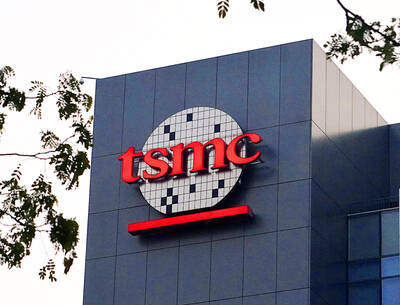US trade flows are realigning on the back of COVID-19 pandemic shocks and tensions with China, but efforts to reduce interdependence between the superpowers have not brought a swift decoupling.
While security concerns have escalated and US imports from China fell after Washington and Beijing imposed tit-for-tat tariffs, trade has since climbed again.
The numbers could rise further when last year’s trade data is released next month, pointing to how interlaced the world’s two biggest economies are.

Photo: Bloomberg
However, experts have said that tensions are leaving their mark in other ways.
“US imports from China are well below the trend that they were on before the trade war started,” Peterson Institute for International Economics senior fellow Mary Lovely said.
“There is definitely a turn away from China in US imports, especially or primarily in those goods on which the US raised tariffs,” Lovely said.
After the trade dispute began, the value of US goods imported from China dropped from US$506 billion in 2017 to about US$450 billion in 2019.
Bilateral relations are not the only factors affecting trade. The pandemic took a heavy toll as well.
China in November last year experienced its sharpest drop in exports since the start of COVID-19, with business activity slammed by its strict “zero COVID” policy.
Also weighing on imports is an “ongoing shift in the US away from spending on goods,” Oxford Economics chief US economist Ryan Sweet said.
Americans spent heavily on imported products during the pandemic, but “people are going back out and spending on services” as virus concerns ease, Sweet said.
This cuts into demand for goods and can help explain why numbers have not surged more, he added.
For now, US government figures through to November show that total US-China trade last year could have approached or hit a high.
“Going forward, you’re going to see more diversification,” as opposed to a complete cut-off of shipments from China, Sweet said.
Auto manufacturers, for example, experienced supply chain problems during the pandemic.
Increasing climate-related disruptions are also “raising the risks of overconcentrated supply chains in one firm or one geographic area,” said Robert Koopman, a lecturer at American University and a former WTO chief economist.
Meanwhile, the administration of US President Joe Biden is trying to make the US more self-reliant in specific sectors such as semiconductors.
“The recent [Inflation Reduction Act] and CHIPS Act, and related sanctions, are clear indicators of the Biden administration’s efforts to decouple from China” in these areas, Koopman said.
“As companies reassess risk and review the current state of their supply chains, one consistent outcome is movement... away from China to other countries,” Center for Strategic and International Studies senior fellow Emily Benson said.
These are countries in Southeast Asia and some others closer to the US.
“While this trend is growing, it resembles sand leaking out of a bag more than it does a tsunami,” she said.
It is likely “too early” for definitive comments on industries, but US export controls “are going to force some decoupling” over time in technology or areas where semiconductors are key, Benson said.
Some business has moved from China to countries like Vietnam or Mexico.
“There’s definitely been some substitution of suppliers,” Lovely said, adding that is fueled partly by Chinese investors who have opened factories outside their home country.
“In Mexico, it’s a different story,” Lovely said. “There has been some Chinese investment, but a lot of it is multinationals who were moving closer to the US.”
However, countries such as Mexico need domestic reforms to boost competitiveness and lower implicit trade costs before reaping greater benefits, Koopman said.
US goods imported from the EU are also catching up, with year-to-date numbers for last year reaching US$504.4 billion in November last year. This was above the US$499.5 billion worth of goods from China over the same period.
However, economists point to a post-pandemic uptick in commercial activity worldwide to explain the trend.
“These figures are a small snapshot and are more likely representative of the global economy returning to pre-pandemic levels than any specific decoupling movement,” Benson said.
As China recovers from an infections surge after easing COVID-19 rules, it also expects a noticeable rise in imports, Chinese Vice Premier Liu He (劉鶴) said earlier this month in Davos, Switzerland.

CHIP RACE: Three years of overbroad export controls drove foreign competitors to pursue their own AI chips, and ‘cost US taxpayers billions of dollars,’ Nvidia said China has figured out the US strategy for allowing it to buy Nvidia Corp’s H200s and is rejecting the artificial intelligence (AI) chip in favor of domestically developed semiconductors, White House AI adviser David Sacks said, citing news reports. US President Donald Trump on Monday said that he would allow shipments of Nvidia’s H200 chips to China, part of an administration effort backed by Sacks to challenge Chinese tech champions such as Huawei Technologies Co (華為) by bringing US competition to their home market. On Friday, Sacks signaled that he was uncertain about whether that approach would work. “They’re rejecting our chips,” Sacks

It is challenging to build infrastructure in much of Europe. Constrained budgets and polarized politics tend to undermine long-term projects, forcing officials to react to emergencies rather than plan for the future. Not in Austria. Today, the country is to officially open its Koralmbahn tunnel, the 5.9 billion euro (US$6.9 billion) centerpiece of a groundbreaking new railway that will eventually run from Poland’s Baltic coast to the Adriatic Sea, transforming travel within Austria and positioning the Alpine nation at the forefront of logistics in Europe. “It is Austria’s biggest socio-economic experiment in over a century,” said Eric Kirschner, an economist at Graz-based Joanneum

BUBBLE? Only a handful of companies are seeing rapid revenue growth and higher valuations, and it is not enough to call the AI trend a transformation, an analyst said Artificial intelligence (AI) is entering a more challenging phase next year as companies move beyond experimentation and begin demanding clear financial returns from a technology that has delivered big gains to only a small group of early adopters, PricewaterhouseCoopers (PwC) Taiwan said yesterday. Most organizations have been able to justify AI investments through cost recovery or modest efficiency gains, but few have achieved meaningful revenue growth or long-term competitive advantage, the consultancy said in its 2026 AI Business Predictions report. This growing performance gap is forcing executives to reconsider how AI is deployed across their organizations, it said. “Many companies

Taiwan’s long-term economic competitiveness will hinge not only on national champions like Taiwan Semiconductor Manufacturing Co. (TSMC, 台積電) but also on the widespread adoption of artificial intelligence (AI) and other emerging technologies, a US-based scholar has said. At a lecture in Taipei on Tuesday, Jeffrey Ding, assistant professor of political science at the George Washington University and author of "Technology and the Rise of Great Powers," argued that historical experience shows that general-purpose technologies (GPTs) — such as electricity, computers and now AI — shape long-term economic advantages through their diffusion across the broader economy. "What really matters is not who pioneers